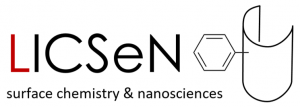Electrografting of vinylic polymers onto conducting surfaces has historically been achieved via a direct electron transfer from the cathode to the electro-active monomers in solution. The resulting radical-anion, together with the anions that allow the propagation of the growing grafted polymer chains, are highly sensitive to proton sources. The « classical » cathodic electrografting process thus requires strictly anhydrous conditions.
Radical polymerization does not suffer the same drawback and is easily performed in aqueous conditions. We thus demonstrated that cathodic electrografting on conducting surfaces can be achieved in protic conditions, provided the polymerization is radically initiated by an electro-active moiety. The best initiators are actually diazonium salts.
Indeed, as shown by Pinson, diazonium salts can be easily electro-grafted on conducting substrates by cathodic reduction to phenyl radical species in mild conditions. However, when the applied potential is higher than the reduction potential of the diazonium salt, a significant part of the resulting phenyl radicals are diverted to the solution and may act as initiators of radical processes. We demonstrated that this initiation is efficient and delivers polymer chains from vinylic monomers solubilized within the electrolyte (either directly or in micellar conditions). The resulting polymer chains normally grow in solution or within the micelles, and are eventually terminated by any radical or radical scavenger present in the medium. Among the termination processes, the most interesting is the reaction of the growing polymer chains with the already grafted aromatic rings coming from the direct electrografting of the diazonium initiator. Hence, the diazonium salt acts both as an initiator for the radical polymerization in solution, and as a primer for the chemical grafting of the resulting polymer chains on the surface of the electrode.
Angle-resolved XPS analysis confirmed that the polyphenylene grafted films arising from the direct electrografting of the diazonium moieties are actually located below the vinylic chains, in direct contact with the electrode.

That new grafting process we called SEEP (Surface Electroinitiated Emulsion Polymerization) allows the formation of truly grafted polymer films from aqueous media, provided suitable surfactants are used to solubilize the polymer precursors. From the mechanistic point of view (Fig. 1), SEEP combines the ‘grafting to’ and ‘grafting from’ methods in one fast electrochemical step at room temperature. [1-5]
More recently, we demonstrated that SEEP allows the true chemical grafting of various polymer on any conducting surface, including for example the surface of nano-objects like carbon nanotubes (Fig. 2). [2]
Contact: G. Deniau
REFERENCES
(1) Tessier, L.; Deniau, G.; Charleux, B.; Palacin, S.; Surface Electroinitiated Emulsion Polymerization (SEEP): A mechanistic approach; Chem. Mater. 2009, 21, 4261–4274.
(2) Tessier, L.; Chancolon, J.; Alet, P.-J.; Trenggono, A.; Mayne l'Hermite, M.; Deniau, G.; Jégou, P.; Palacin, S.; Grafting organic polymer films on surfaces of carbon nano-tubes by Surface Electroinitiated Emulsion Polymerization; Physica Status Solidi A 2008, 205, 1412-1418.
(3) Deniau, G.; Azoulay, L.; Bougerolles, L.; Palacin, S.; Surface Electroinitiated Emulsion Polymerization: grafted organic coatings from aqueous solutions; Chem. Mater. 2006, 18, 5421-5428.
(4) G. Deniau, Patent FR06 08945, 12/10/2006
(5) G. Deniau et al., Patent FR06 01804, 28/02/2006






